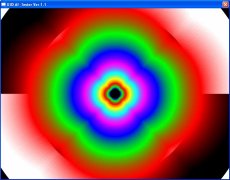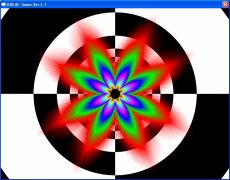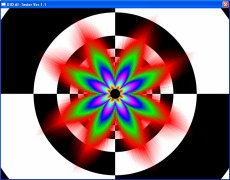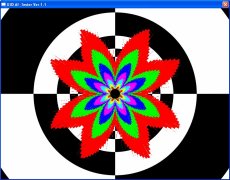Image Quality
Here we'll take a look at some of the advanced image quality options available on the X800 series, so that you'll know what you are getting when you select the higher levels of filtering of FSAA when you enable them in the application or the control panel.
Texture Filtering
Here we'll take a look at some of the texture filtering options available on the X800.
| Trilinear Filtering | Application 16x Anisotropic Filtering |
With the default driver settings the Trilinear Filtering looks pretty much as it should, and largely unchanged from how R300 filtered. With Application 16X Anisotropic Filtering (AF) we can see that R420 retains R300’s angle dependency, with it 16X AF being achieved at the 90° angles, 8X AF at the 45° and dropping down to 2X AF at the worst cases. With application controlled AF, the same filtering levels and types are applied across all texture layers.
When using Control Panel controlled Anisotropic Filtering we can see that with the first texture layer full filtering is applied, as with application filtering, however with texture stages greater than the first layer the filtering drops back to Bilinear. This appears to remain unchanged from the control panel options that featured for much of the R300 generation.
FSAA
Here we'll take a look at the FSAA image quality options available with the Radeon X800.
 |  |  |
As the above images show, the FSAA options available of Radeon X800 remain basically the same as R300’s options – three modes are provided (2X, 4X, 6X), based on the same sparse sampled Multi-Sampling algorithm and with Gamma correction. Even the sample positions remain unchanged (although if they were viewed to be optimal, this should be no surprise). However, thanks to the flexibility of ATI’s programmable sparse sampled scheme they are introducing a new mode dubbed “Temporal FSAA”
Temporal FSAA works on the principal of altering the FSAA sampling positions between frames, such that dependant on the persistence of the display device it can give the illusion of a greater level of FSAA sampling than is actually being rendered. The sampling patterns of the Temporal AA modes are as follows:
| 2Xt |  |  |  |
| 4Xt |  |  |  |
| 6Xt |  |  |  |
You can see that for the first frame one sample pattern is used in each mode, and then for the second frame another pattern is used – in fact, the positions for the 2X mode add up to the standard 4X mode.
The visual effects of Temporal AA only really pay off when the frame rate exceeds that of the monitor refresh rate, so there are restrictions placed on the use of Temporal AA. First this will only be available as a control panel option, never selectable directly from a game, and also when this is selected VSYNC must be used (clicking the option may force VSYNC on). Should the performance drop below around 60 FPS then Temporal AA can actually create some visual disturbances in the way of flicker, so ATI will put a performance threshold on it – should the performance drop below the 60 FPS threshold for a sustained number of frames then the AA will drop back to the standard mode for the base level selected (so 2X AA for 2X Temporal AA), and should the performance rise back above 60 FP it will be re-enabled. Theoretically the net result of this is that if, for instance, 2X Temporal AA is selected the worst quality FSAA you’ll get is just the basic 2X FSAA mode, but at best it could approach that of the appearance of 4X FSAA for the same performance cost.
Temporal AA will not be enabled in initial Radeon X800 drivers, but will be in a larger Catalyst update ATI are set to make. When it does appear there is a high probability this will also be available on R300 based cards (Radeon 9500 and above), however due to the higher performance of Radeon X800 these new boards are likely to stay over the 60 FPS threshold in more cases and hence the mode will be more useful on these boards.




